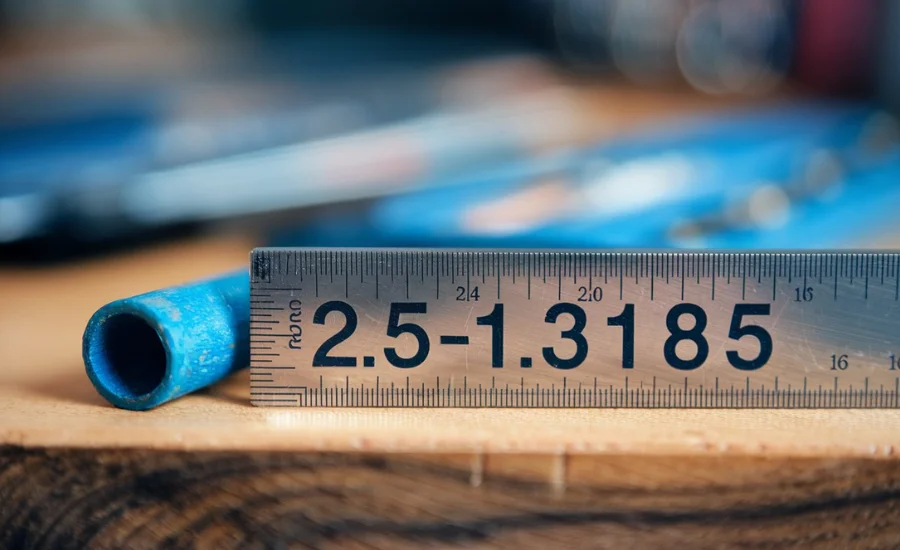In disciplines such as engineering, mathematics, and technical assessments, ratios and specific numerical values play a crucial role. One such example is the ratio of 2.5 to 1.3185, which signifies important relationships among various dimensions and tolerances. These values are integral to precise calculations, manufacturing processes, and quality assurance protocols.
This article delves into the significance of the 2.5-1.3185 ratio, examining its applications across different fields and highlighting its influence on measurement practices and engineering principles. Understanding these ratios can enhance accuracy in projects and improve overall efficiency in technical operations.
Understanding the 2.5-1.3185 Ratio
At its core, the 2.5-1.3185 ratio signifies a specific relationship between the two values: 2.5 and 1.3185. This relationship is essential in various technical and mechanical calculations, serving as a foundation for understanding complex systems such as gear ratios and mechanical leverage. In many engineering contexts, precise ratios like 2.5-1.3185 ensure that components fit together correctly and operate efficiently, minimizing the likelihood of errors and optimizing performance in machinery, electronics, and architectural designs.
Fun with Numbers: Breaking Down 2.5-1.3185
Let’s break down the 2.5-1.3185 ratio further. At first glance, it may seem like a simple subtraction problem. When you subtract 1.3185 from 2.5, you get:2.5−1.3185=1.18152.5 – 1.3185 = 1.1815 2.5−1.3185=1.1815
This result highlights how ratios can represent differences in quantities, making them useful for comparisons in various contexts. Whether in mathematics, science, or everyday scenarios, understanding the application of the 2.5-1.3185 ratio can lead to better decision-making.
The Significance of the 2.5-1.3185 Ratio in Engineering and Measurement
In various domains, especially in engineering, mathematics, and technical assessments, ratios and specific numerical values are vital. The ratio 2.5-1.3185 is an important representation of the relationships between dimensions, tolerances, and other critical parameters. Such values are essential for accurate calculations, manufacturing processes, and quality control measures.
This article explores the relevance of the 2.5-1.3185 ratio, examining its applications across different fields and its impact on measurement and engineering practices. Understanding the significance of this ratio can lead to improved precision in various projects and enhance efficiency in technical operations.
The Importance of the 2.5-1.3185 Ratio in Technical Applications
The ratio 2.5-1.3185 represents a specific relationship between two numerical values that is critical in various technical and engineering fields. Understanding this ratio can significantly enhance calculations related to gear ratios, mechanical leverage, and unit conversions. Precise ratios like 2.5-1.3185 ensure that components fit and operate together seamlessly, minimizing errors and optimizing performance in machinery, electronics, and architectural design.
In mechanical systems, the 2.5-1.3185 ratio is particularly relevant in defining gear ratios, which illustrate the relationship between the speeds of two rotating parts. For example, a gear ratio of 2.5-1.3185 indicates that for every 2.5 rotations of one gear, the other gear completes 1.3185 rotations, effectively transferring torque and ensuring the efficient operation of mechanical systems. Additionally, this ratio plays a crucial role in unit conversions, allowing engineers and technicians to accurately translate measurements across different systems, such as converting from imperial to metric.
In manufacturing, strict adherence to tolerances guided by ratios like 2.5-1.3185 is essential for maintaining quality control. Deviations from this standard could result in parts that fail to fit correctly or perform as intended, particularly in critical industries like aerospace. Furthermore, in the field of electronics, this ratio may represent important relationships among electrical currents, voltages, or resistances, ensuring that devices function reliably without overheating or signal loss.
Practical Applications of 2.5-1.3185 in Everyday Life

The ratio 2.5-1.3185 also has practical applications that extend into everyday life, demonstrating its relevance beyond technical fields. For instance, it can be employed in shopping scenarios where discounts are involved. If a product costs $2.50 and a coupon provides a discount of $1.3185, the total cost would be reduced to $1.1815, illustrating how this ratio can lead to tangible savings.
In educational settings, students encounter similar numerical comparisons, utilizing the ratio to solve subtraction problems or to understand differences between quantities. For example, if one sports team scores 2.5 points and another scores 1.3185 points, the difference of 1.1815 points reflects the competitive edge of the winning team.
Understanding ratios like 2.5-1.3185 enhances our ability to measure, compare, and analyze various situations effectively. Whether it’s in mathematical calculations, scientific applications, or practical day-to-day activities, familiarity with such ratios empowers individuals to navigate challenges with confidence.
As we look to the future, the evolution of standards like 2.5-1.3185 will continue to adapt to technological advancements, ensuring their relevance and utility across industries. As new challenges arise, maintaining the integrity of these standards will be essential for ensuring safety, performance, and innovation in an ever-changing landscape.
Key Features
One of my standout features is natural language understanding, which enables me to comprehend context, nuances, and various topics. This allows me to generate relevant and coherent responses tailored to your needs. For instance, if you ask about the principles of quantum mechanics, I can not only provide a definition but also explain complex concepts like wave-particle duality or the uncertainty principle in a way that’s easier to understand. This adaptability makes me a versatile tool for users across different knowledge levels.
In addition to factual information, I also excel in creative writing, assisting with tasks such as storytelling, poetry, and brainstorming ideas. Whether you’re a student looking for help with a narrative essay or a writer seeking inspiration for a novel, I can provide prompts, character development suggestions, and even plot outlines. My capability to generate original content can aid in overcoming writer’s block and enhancing creativity.
For technical subjects, I can explain complex concepts in fields like engineering, mathematics, and computer science, making them more accessible. For example, if you’re struggling to understand calculus concepts such as derivatives and integrals, I can provide explanations and examples that break down these topics into digestible parts. This can be particularly useful for students or professionals looking to reinforce their understanding of challenging subjects.
Moreover, I offer support in multiple languages and can assist with translations, enhancing communication across different linguistic contexts. This capability allows users to converse in their preferred language and receive accurate translations, making information accessible to a broader audience.
Limitations

While I possess many strengths, I also have limitations. Currently, I do not have memory, which means I cannot recall past interactions or retain information shared for future conversations. Each session is independent, meaning I can provide assistance based only on the context available during our current exchange. This limitation ensures user privacy but can make it challenging to maintain continuity in long-term projects.
Additionally, I lack browsing capabilities, so I don’t have access to real-time information or the internet. My knowledge is based on data up to September 2021, which means I may not have the latest updates on certain topics, such as recent technological advancements or current events. Users should keep this in mind when seeking information on time-sensitive matters.
Moreover, while I strive for accuracy, I may not always provide perfect information. For instance, there may be nuances or recent developments in various fields that I might not be aware of. Therefore, it’s essential for users to verify critical data from reliable sources when necessary, especially when making decisions based on the information I provide.
Ethical Considerations
I am designed to follow ethical guidelines, which include promoting respectful dialogue, avoiding harmful content, and respecting user privacy. This means that I am programmed to engage in conversations that foster a positive and constructive environment. I do not generate personal data or sensitive information, ensuring that conversations remain safe and appropriate.
These ethical considerations extend to how I handle sensitive topics as well. For instance, when discussing mental health, I aim to provide supportive information while encouraging users to seek professional help if needed. This approach reflects a commitment to user well-being and responsible information sharing.
Use Cases
I can be a valuable resource in various scenarios. In education, students can utilize my capabilities for explanations, summaries, or homework assistance. For example, if a student is studying for a history exam, I can provide concise summaries of key events, figures, and themes, helping them to prepare effectively.
Writers can find inspiration, generate ideas, or seek help with drafts through my creative writing support. Whether you’re drafting a short story or developing a screenplay, I can assist in crafting dialogue, developing characters, and refining plots. Additionally, I can offer feedback on writing style and structure to help improve overall quality.
Moreover, individuals looking for problem-solving guidance can ask for advice or clarification on specific issues. For instance, if someone is facing a challenge in project management, I can suggest strategies, tools, and best practices to enhance productivity and efficiency.
Interactivity
I’m here to assist you! My interactive capabilities allow for a dynamic exchange of information. You can feel free to ask questions, request explanations on specific topics, or seek help with writing tasks. Whether you’re looking for detailed information or just a quick answer, I’m ready to help and provide the information you need.
In addition, I can adapt my responses based on your preferences. For instance, if you prefer concise answers or more elaborate explanations, I can adjust my style accordingly. This adaptability makes our interactions more effective and tailored to your specific requirements.
Overall, my purpose is to facilitate learning, creativity, and problem-solving across various contexts. Whether you’re a student, a professional, or just someone curious about a topic, I’m equipped to support your endeavors. If there’s anything specific you’d like to know more about or any topic you want to explore, please let me know!
Conversion Factors in Engineering

Beyond gear ratios, the 2.5-1.3185 ratio is instrumental in unit conversion processes. Engineers frequently encounter situations requiring conversions between different measurement systems, such as switching from imperial to metric units. The 2.5-1.3185 ratio may represent a tailored conversion factor for specialized applications, helping to maintain accuracy while preventing errors that could arise from rounding or using imprecise conversion methods.
Tolerances and Specifications
In manufacturing, adherence to precise tolerances is vital for maintaining quality control. Ratios like 2.5-1.3185 dictate the acceptable tolerance range for parts, ensuring that each component meets the required specifications. Deviations from this ratio can result in components that do not fit properly or fail to perform as expected. For instance, in aerospace engineering, even minor variations from a defined tolerance such as 2.5-1.3185 could lead to mechanical failures, emphasizing the importance of maintaining rigorous standards throughout the production process.
Relevance in Electronics and Circuitry
For example, an amplifier may require a specific ratio between input and output signals to achieve optimal performance levels. Additionally, this ratio may be used in the design of transformers and other electronic components, where efficiency in energy transfer is crucial. Engineers rely on precise ratios like 2.5-1.3185 to ensure electronic devices operate reliably, avoiding issues such as overheating or signal degradation.
Impact on Construction and Architecture
In construction and architectural design, ratios are fundamental in determining dimensions, materials, and structural integrity. Ratios like 2.5-1.3185 can dictate the proportions of critical components such as beams, walls, or columns, ensuring that structures are both aesthetically pleasing and structurally sound. For example, the 2.5-1.3185 ratio could represent specific dimensional requirements for a load-bearing column, helping to ensure it can withstand the forces it encounters. Adhering to such ratios is crucial in large-scale projects, as even minor deviations can lead to significant structural issues.
Calculating Efficiency and Performance
Ratios like 2.5-1.3185 are also essential for calculating efficiency and performance across mechanical and industrial systems. Maintaining the correct ratio can have a direct impact on overall system efficiency, particularly in energy production, automobile design, and manufacturing processes. For instance, the ratio may be part of optimization formulas aimed at improving energy efficiency in turbines or enhancing fuel efficiency in engines. In this context, precise ratios help engineers strike a balance between performance and resource consumption, contributing to the development of more sustainable systems.
Everyday Applications of 2.5-1.3185
Even outside technical fields, the 2.5-1.3185 ratio has practical applications. For example, when shopping, if a candy bar costs $2.50 and you have a coupon for $1.3185 off, subtracting the coupon amount results in a final price of $1.1815. Similarly, in educational settings, students can practice subtraction and comparisons using this ratio to reinforce their math skills.
In sports, comparing scores can also utilize this ratio; if one team scores 2.5 points and the other scores 1.3185 points, the difference of 1.1815 points shows the winning margin. Understanding such ratios enhances our ability to measure, compare, and analyze various situations, empowering individuals in their daily lives.
Future of 2.5-1.3185

The future of the 2.5-1.3185 ratio and its applications across various fields will likely evolve as industries and technologies advance. One of the most significant trends influencing this evolution is technological advancement. As engineering and design methodologies develop, the use of ratios like 2.5-1.3185 will adapt to incorporate new tools and processes. For example, with the rise of advanced manufacturing techniques, such as 3D printing and additive manufacturing, engineers may need to refine existing ratios or create new ones that accurately reflect the unique properties of emerging materials.
Automation and smart technologies are becoming increasingly prevalent in manufacturing and engineering, which could further shape the relevance of the 2.5-1.3185 ratio. By integrating this ratio into automated systems that monitor and adjust production parameters in real time, industries can reduce human error and enhance overall quality control. As machines become more intelligent, they could automatically optimize performance based on such ratios, leading to increased efficiency in mechanical operations.
Another critical area likely to influence the future of this ratio is sustainability. As industries prioritize environmentally friendly practices, the 2.5-1.3185 ratio may be revisited to improve energy efficiency and reduce waste. Engineers could develop new conversion factors that help minimize resource consumption during manufacturing processes, ensuring that products meet sustainability standards while maintaining performance quality.
The demand for customization in products and services is also on the rise, requiring ratios like 2.5-1.3185 to be more flexible. In sectors such as automotive design and aerospace engineering, where tailored solutions are essential, engineers may adapt these ratios to cater to the unique requirements of specific projects. This adaptability will help refine the understanding of how such ratios influence design and performance outcomes.
Ongoing research and development will play a vital role in exploring the implications and applications of the 2.5-1.3185 ratio. Collaboration between academic institutions and industry partners may lead to investigations into how these ratios can enhance performance and reliability while driving innovation. Such research initiatives could result in new standards and practices that redefine how ratios are employed in engineering and technical fields.
As disciplines increasingly intersect, the applications of ratios like 2.5-1.3185 may expand beyond traditional engineering domains. In fields such as biotechnology and environmental science, these ratios could be adapted to tackle complex challenges, such as optimizing energy usage in biological systems or assessing ecological impacts. This interdisciplinary approach could lead to novel applications and methodologies that enhance our understanding of these ratios.
Furthermore, the ongoing digital transformation of industries may significantly impact how ratios like 2.5-1.3185 are utilized. With advancements in data analytics, machine learning, and simulation tools, engineers can analyze complex systems more effectively, leading to better-informed decisions regarding ratios and their implications. By leveraging big data, professionals can refine their understanding of how these ratios influence performance, efficiency, and safety across various applications.
Also Read: 32.32 65-4-4.44 4.21-74.09
Final Words
The 2.5-1.3185 ratio is significant across various technical fields, including engineering, manufacturing, and electronics. It represents precise relationships that are critical for ensuring accuracy in calculations, gear ratios, tolerances, and unit conversions. In mechanical systems, the ratio helps optimize performance by regulating the speeds and torque between interconnected parts, while in manufacturing, adherence to such ratios is vital for quality control and product reliability. Beyond industrial applications, the 2.5-1.3185 ratio also finds use in everyday contexts, like calculating discounts or comparing values. As technology evolves, this ratio will remain essential for maintaining efficiency and precision in diverse sectors.
Unlock the power of precision and efficiency in your projects by mastering the significance of the 2.5-1.3185 ratio with Discover Outlook.
